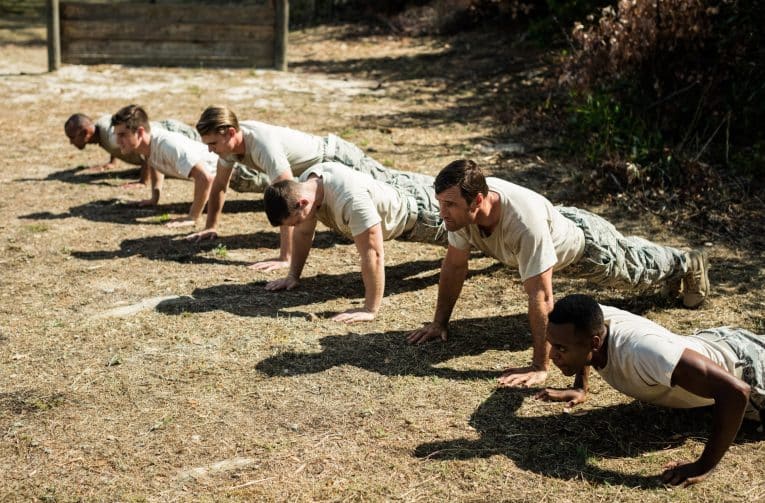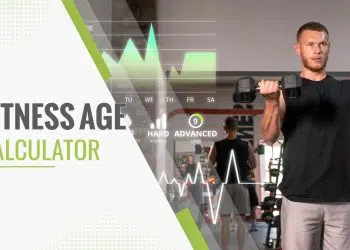Soldiering is arguably the world’s oldest profession. Since the beginning of history, nations have relied on their armies to defend and expand their borders. Often, peace is only maintained by a strong military presence.
Professional soldiers need to be fit enough to fight until their enemies are defeated. Mechanized combat means that some types of soldiers need to be fitter than others. For example, special forces operatives and infantry need a higher fitness level than tank crews.
That said, all soldiers in the US army must reach and maintain a basic level of fitness. This is evaluated using the Army Physical Fitness Test, or APFT.
Use our APFT calculator to assess your fitness and see how you compare to the average soldier.
Army Physical Fitness Test (APFT) Calculator
Results:
APFT Score:
PUSH-UPS:
SIT-UPS:
RUNNING:
What is APFT Calculator?
The Army Physical Fitness Test (APFT) is a series of assessments that every member of the US army must pass. It is typically conducted twice a year, and soldiers are required to reach the minimum standards for their gender and age group. Those that don’t will be remanded to remedial PT, and face being discharged if they do not reach the required standard next time.
While any soldier will pass the APFT by hitting the minimum targets, participants are encouraged to exceed these standards, especially if they want to be considered for promotion. Just scraping by is not the army way! As such, soldiers often take great pride in their APFT scores, attempting to better them year after year.
Level Up Your Fitness: Join our 💪 strong community in Fitness Volt Newsletter. Get daily inspiration, expert-backed workouts, nutrition tips, the latest in strength sports, and the support you need to reach your goals. Subscribe for free!
The APFT comprises three stages:
1. Two minutes of push-ups
Push-ups develop and test upper body strength and endurance, focusing on the chest, arms, and shoulders. Push-ups are a common military exercise, and all soldiers are more than familiar with this classic movement.
Soldiers must perform their push-ups in the military fashion, i.e., using strict form:
- Adopt the high plank position with arms, legs, and body straight. Hands should be roughly shoulder-width apart.
- Bend your arms and lower your chest to within an inch of the floor. Your body must remain straight and move as a single unit. Arms are generally kept close to the body.
- Extend your arms fully and repeat.
2. Two minutes of sit-ups
Sit-ups may have fallen out of favor in civilian gyms, but they’re still a popular exercise in the military. Sit-ups test and develop abdominal endurance and strength. Strong abs are vital during almost every physical activity, including lifting can carrying heavy weights. They also reduce the risk of developing lower back pain.
To perform APFT-standard sit-ups:
- Sit on the floor with your legs bent at 45 degrees and feet flat. Place your hands on your temples.
- Sit up until your torso is vertical, i.e., your head is directly over your hips.
- Lie back down until your shoulder blades touch the floor, and repeat.
3. 2-mile run
The final part of the APFT is a timed 2-mile run. This test assesses cardiovascular fitness. Participants are allowed to walk, but this is strongly discouraged, and soldiers are expected to be able to run the entire distance without stopping.
All of the assessments in the APFT are usually performed back-to-back, with just a few minutes between each discipline.
How to Use the Army Physical Fitness Test Calculator
The Army Physical Fitness Test (APFT) calculator is straightforward to use. Just follow these step-by-step instructions to see how your fitness compares to soldiers in your age bracket.
- Enter your age in years.
- Select your gender, choosing between male or female.
- Perform as many push-ups as possible in two minutes, and then enter your score.
- Perform as many sit-ups as possible in two minutes, and then enter your score.
- Run two miles as fast as possible and then enter your time.
- Hit “calculate.”
- Read off your results in the box below.
Interpreting your Results
The Army Physical Fitness Test (APFT) calculator compares your performance in the three stages to the normative tables for your gender and age. Younger soldiers are expected to perform better than older soldiers, and the standards for women are lower than the standards for men.
Each event has a maximum score of 100 points, and soldiers must achieve a minimum score of 60 points per discipline and 180 points in total to pass. Scores are adjusted for age and gender.
For example, a 25-year-old male soldier must do between 40-74 push-ups to pass the APFT, whereas a 45-year-old female must do 12 to 37. The more reps you do, the closer to 100 your score will be.
After entering your results, you will receive the following results:
- Score out of 300 and whether you passed or failed the APFT
- Push-up points out of 100 and whether you passed or failed
- Sit-up points out of 100 and whether you passed or failed
- 2-mile run points out of 100 and whether you passed or failed
If you fail any part of the test, the calculator will tell you how many more reps or how much faster you need to run in order to achieve the minimum standard and receive a pass.
In addition, you’ll also see your results for each discipline and the minimum required standard for your gender and age group.
How to Improve your Score
For most soldiers, it’s not enough just to pass the APFT; they want to improve their score to increase their standing within their unit and enhance their chances of promotion.
Strategies for improving your APFT score include:
Push-ups
Push-ups are a test of relative strength, which is your strength compared to your body weight. Losing fat, which is dead weight, will make push-ups easier so you can do more reps in the allotted time.
If you are overweight, it’s time to overhaul your diet and shed the pounds that are weighing you down.
In addition to losing weight, you’ll find push-ups easier if you get stronger. Effective exercises for building push-ups strength include:
- Barbell and dumbbell bench presses
- Parallel bar dips
- Chest press machine
- Weighted vest push-ups
Finally, get better at push-ups by making them the cornerstone of your upper-body workouts. Do them first when your energy is highest. However, don’t just do one set to failure. Instead, do multiple sets of 60-70% of the maximum number of push-ups you can currently do.
For example, if your best push-up score is 25 reps, do 3-4 sets of 15 to 18 reps, resting two minutes between each one. Gradually add more reps to each set as you get stronger.
You could also try greasing the groove, or GTG for short. With this training method, you do sets of about 50% of your repetition maximum throughout your day, accumulating as many sets as possible without getting tired. For example, you could do 10 push-ups every waking hour. All of these submaximal sets will quickly increase your maximal push-up performance.
Sit-ups
Like push-ups, sit-ups are a test of relative strength and endurance, and losing weight will make them more manageable. So, clean up your diet if you know you’re carrying too much body fat.
Also, make sure you train your abs several times a week. Sit-ups should be a big part of your abs workouts, but other exercises to consider include:
Level Up Your Fitness: Join our 💪 strong community in Fitness Volt Newsletter. Get daily inspiration, expert-backed workouts, nutrition tips, the latest in strength sports, and the support you need to reach your goals. Subscribe for free!
- Planks
- Crunches
- Cable crunches
- Hanging knee raises
- Hanging leg raises
- Abs wheel rollouts
Use the same training strategies discussed for push-ups, including greasing the groove. However, take care when doing lots of sit-ups, as they can be hard on your lower back. Use other exercises to strengthen your abs while being kinder to your spine.
Running
Running is a standard part of military life, and most soldiers are expected to be proficient runners. That said, running can be hard, and it’s something that a lot of people struggle to do well.
To get better at running, you need to run more, so aim to run at least three times per week, but not more than five.
However, running as fast as possible is NOT the best way to improve your running speed. Instead, you need to run at a slower, more sustainable pace to increase your basic cardiovascular fitness. Once you have a decent level of running fitness, you’ll be ready to add some speed work and learn to run faster.
So, your first objective should be to run two miles at a comfortable pace without stopping. Initially, you may need to adopt a run/walk program, but as you get fitter, you will be able to run more and walk less. Go as slow as you need to so you can cover the prescribed distance.
Once you can run two miles without stopping, it’s time to start running further. Increase your training runs from two miles to 2.5, three, and then four miles. However, don’t rush these increases, and only raise the distance when you feel you are ready. This process may take several months.
When you can run four miles reasonably comfortably, it’s time to start running faster. You can do this in several ways.
Try them all and see which works best for you:
- Faster one to two-mile runs
- Intervals, e.g., run fast for two minutes, walk for two minutes, repeated 6-8 times
- Fartlek – run 2-3 miles but include short bursts of faster running
Do 1-2 speed workouts per week, making sure you still continue your longer, slower runs.
After several months of training, your two-mile APFT time should be significantly faster.
APFT FAQ
1. What is the Army Physical Fitness Test (APFT) calculator?
The Army Physical Fitness Test calculator is a tool designed to give you a score for the APFT. The APFT is the standard fitness test used by the UA army.
Because participants are graded based on their gender and age, there are LOTS of tables for determining your results. This calculator eliminates the need to use those tables and makes it much easier to score your APFT.
In addition to revealing your total APFT score and result per discipline, this calculator will also tell you the minimum standards you need to achieve for your age and gender and, if you fall short, how much more work you need to do to pass.
2. Do Navy SEALs need to pass the APFT?
Navy SEALs have their own fitness assessment called the PST. It’s much more demanding than the APFT, and SEALs are expected to achieve higher scores across more tests than the average soldier.
The assessments in the PST are:
- Swim 500-yards using breast and/or sidestroke in less than 12 ½ minutes
- 10-minute rest
- Perform a minimum of 50 push-ups in 2 minutes
- 2-minute rest
- Perform a minimum of 50 sit-ups in 2 minutes
- 2-minute rest
- Perform a minimum of 10 pull-ups (no time limit)
- 10-minute rest
- Run 1½ miles in 10½ minutes or less
Read more about Navy SEAL fitness training here.
3. What is the best way to warm up for the APFT?
The APFT is a maximum-effort fitness test. Warming up will ensure you can perform at your best while minimizing your risk of injury.
To warm up for the APFT:
- Do an easy jog for 5-10 minutes
- Perform some dynamic mobility and flexibility exercises for your main muscles and joints
- Do a couple of sub-maximal sets of push-ups and sit-ups for practice
- Do a few short bouts of fast running, e.g., 30 to 60-seconds
You should now feel warm-up and ready to kick butt during your APFT.
4. How often should I do the APFT?
The APFT is a maximal fitness test, and you’ll only get a good score if you push yourself close to your limits. As such, it can be pretty tiring and will take a lot out of your body. Because of this, you should avoid doing the APFT too often, as doing so could lead to overtraining and will probably cause your scores to get worse instead of better.
Soldiers do the APFT twice a year, but you could do it monthly if you wish. However, the rest of your time should be spent training for the APFT with more manageable, less intense workouts designed to improve your weaknesses and boost your overall score.
5. Can I do the 2-mile run on a treadmill?
Ideally, you should do the run outdoors on a relatively flat, smooth, traffic-free roads – such as an army camp. However, if that is not possible, you can use a treadmill.
However, it’s important to note that most people can run faster on a treadmill than outdoors. There is less wind resistance to overcome, and the motor does some of the work for you. Because of this, you cannot compare indoor and outdoor running times.
So, if you use a treadmill for one APFT 2-mile run, you should also use it for your subsequent tests. Otherwise, you won’t be able to compare one result to the next.
Related Calculators:
We also encourage you to check out our other awesome calculators to help you reach your health, fitness, and performance goals.
- Body Fat US Navy Calculator
- Body Fat Skinfold Calculator
- Grecian Ideal Calculator
- Find Your Body Fat Percentage
- Calories Burned Weight Lifting
- Body Type Quiz
- Calorie Deficit Calculator
APFT Wrapping Up
The Army Physical Fitness Test (APFT) is the basic fitness test of the American military. All soldiers are expected to pass it twice per year, although performance targets are adjusted by age and gender.
The APFT provides a good measure of upper body strength and cardiovascular fitness. However, it’s not as comprehensive as some other military fitness tests, e.g., the SEAL PFT.
The APFT is very easy to administer, as it requires no special equipment. Because of this, every gym goer and home exerciser should be able to attempt it.
See how your fitness stacks up against the soldiers of the US army with the APFT!













